How to Make a Nervous and Immune System Balancing Tea
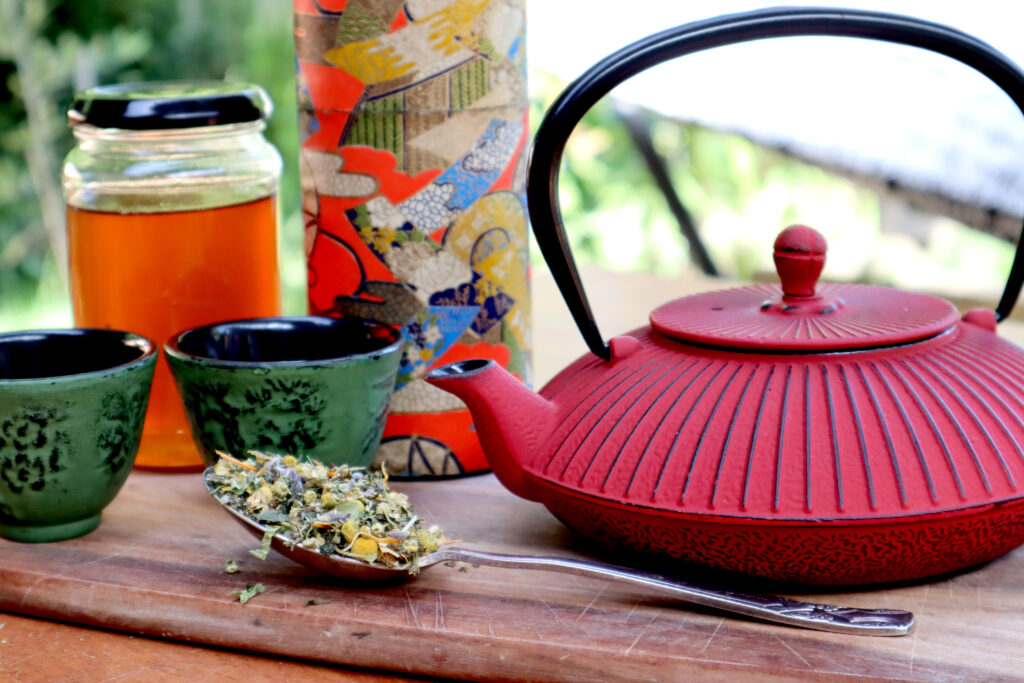
Today I’m sharing my recipe for Nervous and Immune System Balancing Tea.
This beautiful Healing Tea recipe came to me intuitively a couple of years ago. When I was first teaching myself herbalism.
We’ve been drinking this tea just about every day since, as part of my Daily Healing Tea Ritual. We have no plans of stopping, ever. Although the recipe will undoubtedly continue to evolve over time, as our nutritional or medicinal needs change.
Benefits of Nervous and Immune Sytem Balancing Tea
My Nerous and Immune System Balancing Tea is very gentle, yet it packs a powerful nutritional punch. The nutrients are easily absorbed, especially by people with compromised digestive systems. It also works to actively heal the digestive tract.
This tea is free from the artificial additives and fillers found in most “natural” vitamin supplements and commercial herbal extracts. Which can often cause allergic reactions in sensitive people.
As the name suggests, Nervous and Immune System Balancing Tea gradually eases a dysfunctional nervous/immune system back into balance. Then keeps it there (with continued use), reducing your susceptibility to future illness.
It contains mild yet effective sedatives, tranqilisers and muscle relaxants to keep you calm and comfortable.
This tea contains mild blood thinners which may help to reduce the risk of cardiac issues and micro clotting.
It contains antiviral, antibacterial, antimicrobial, antifungal, antiallergenic, antiseptic and neuroprotective ingredients.
Nervous and Immune System Balancing Tea contains diuretics which support your liver, gallbladder and lymphatic system. This helps your body to clear built up waste products, which prevent your body from functioning well. It may also help to inhibit spike proteins (such as those from covid-19) from binding with cells.
It contains an adaptogen, which improves your nervous/immune system’s ability to cope with and recover from stressful events. This reduces the likelihood of stress/trauma induced illness occurring or recurring.
This tea contains quercetin, which is a mast cell stabiliser. Quercetin works to calm a nervous/immune system which is stuck on red alert and may help to reduce allergic reactions.
It aids in connective tissue and nerve repair. This is vital for wound healing and illness recovery, especially chronic illnesses which affect the nerves and connective tissue. Such as the hEDS/POTS/MCAS “trifecta”, fibromyalgia, CFS/ME, long covid, vaccine injury, etc).
My personal experience with Nervous and Immune system balancing tea
Since I have been drinking this tea:
I feel noticeably calmer and better able to tolerate and bounce back from stressful events and experiences.
My joint instability and muscle spasticity is so much better, which means far fewer joint subluxations, migraines etc. I also have reduced nerve pain and paraesthesias.
The chronic back and joint pain I’ve had since childhood is much more manageable. This allows me to be much more functional and productive.
My general pain, energy levels and ability to focus are much better. I’m well enough to be writing this blog after years of being too sick to even get out of bed!
My lymph nodes are less swollen, and inflammation levels are actually normal for once.
The allergic reactions I do have are much milder, usually just hayfever or facial flushing. I don’t have to restrict my diet to avoid “triggers” (except for MSG which causes major bloating).
I heal quicker and don’t bruise as easily.
I feel less nauseous and bloated and my appetite is better.
My “generalised anxiety disorder” (trauma based hypervigilance) and lifelong insomnia (histamine and adrenaline dumping due to trauma based hypervigilance) are things of the past. I fall asleep fairly quickly and tend to sleep well throughout the night, which is something I’d never experienced before. I very rarely need to nap or lie down during the day anymore.
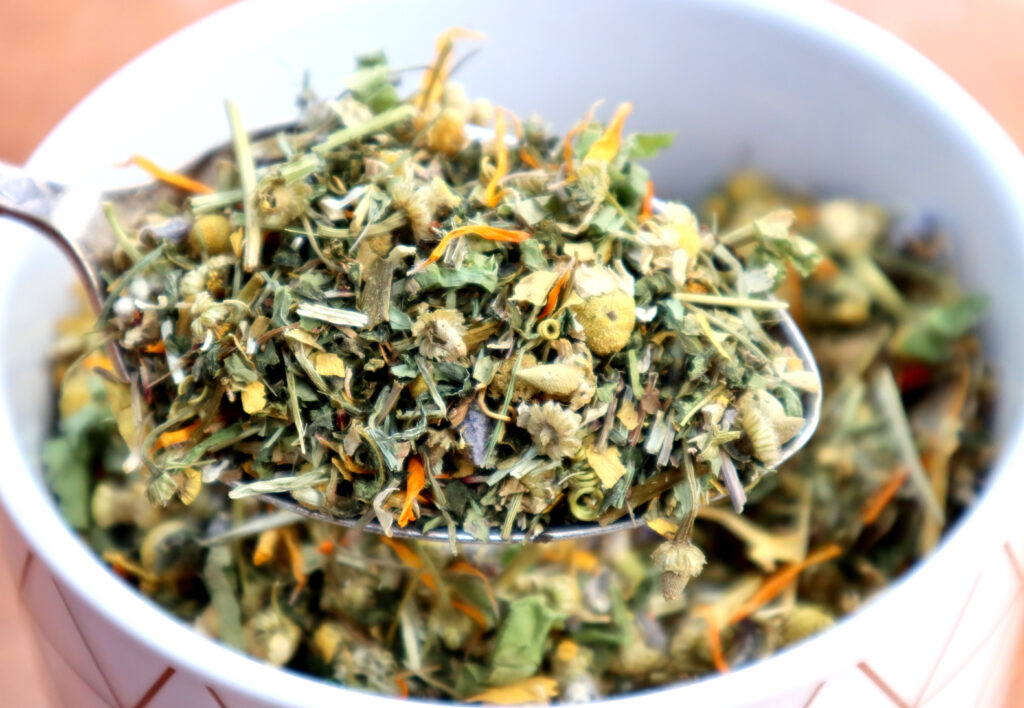
Who might benefit from using Nervous and Immune system balancing tea?
People with chronic illness who want to take control of their own health and healing
Nervous and Immune System Balancing Tea tea is excellent for adults and teenagers with or recovering from chronic illness. Especially those wastebasket diagnosis “it’s all in your head” invisible illnesses. Which western medicine unfortunately doesn’t really know how to treat.
I’m talking CFS/ME, fibromyalgia, the hEDS/POTS/MCAS “trifecta”, long covid, vaccine injury, lyme, etc. I’m currently working on a post about my experience with these kinds of conditions and how I healed them.
It doesn’t matter if you have an official diagnosis of one of these conditions, or you just suspect it. Although I do believe it’s important to try to get more serious conditions ruled out. Especially if you have family history of serious medical issues).
Unfortunately, I’m well aware that not everyone has access to a doctor who won’t dismiss it as “just anxiety” or “depression”, and just throw antidepressants and gabapentin at you. It’s even harder to find one who is capable of understanding, diagnosing and treating these kinds of wastebasket illnesses.
Many chronic illness patients are forced to figure out our own diagnoses and treatments. Then search aimlessly for doctors willing and capable of diagnosing and treating us. Not that diagnosis really changes anything. Because they can only offer meds to treat/mask some of the individual symptoms anyway. Which often come with their own side effects, requiring more meds.
Nervous and Immune System Balancing Tea is part of a holistic approach which allows the patient to take an active role in their own healing process. Besides using this tea in Daily Healing Tea Rituals, I’m also going to link to some other healing information at the end of the post. For those you you who are interested in taking back even more of your healing power.
Chronically ill people who can’t access or afford medical treatment
I’m also aware that many people are unable to afford the countless appointments, tests, scans, treatments, medications, supplements, etc which doctors and specialists may recommend.
I specifically created this Nervous and Immune System Balancing tea because all of the ingredients should be fairly cheaply and readily available to anyone. Herbal medicine will always be the people’s medicine. It is our birthright.
Our gardens and local areas are bursting with free medicine, if we only know how to look for it. Anything we can’t grow or forage ourselves is cheap and easily accessible from a local health food store, tea shop, or online.
I recommend only starting with the base tea and increasing by one ingredient every fortnight. You definitely don’t need to rush out and buy everything all at once, especially if the budget is tight.
I will be making small batches of Nervous and Immune system Balancing tea and selling them in my in my etsy store. But I’m choosing to share my recipe too. Because I want this healing recipe to be accessible and affordable to everyone who needs it.
Is it safe for people with Mast Cell Activation Syndrome?
Honestly, I can’t guarantee it will be safe for everyone, I’d be lying if I said it would be. Every body is different. My husband Dan and I both have MCAS, we find that the tea helps us and we haven’t had a bad reaction to any of these herbs. This doesn’t mean they won’t potentially cause a reaction for you though.
I have listed potential contraindications for each ingredient, but I also strongly encourage you to do your own reading about the herbs listed here. You should discuss them with a trusted medical professional, to decide if they are right for you, before you try them.
If you have MCAS (random allergic reactions to a lot of different things), follow these tips to reduce your risk of allergic reactions:
Only add one herb from the base tea at a time (chamomile, then passionflower, then lavender). Wait two weeks before introducing the next herb. Continue adding one extra ingredient per fortnight as tolerated.
If you tend to be highly reactive to different substances, you should always do a skin patch test with a small amount of tea made from each individual herb a day before ingesting it. Dab some cooled tea on the inside of your wrist and leave overnight. If there’s any irritation the next day, do not use this herb (although you may find that you can tolerate it later down the track when your system has calmed down a bit).
If there’s no irritation on your wrist the next day, you can start with ingesting a very small dose, like a teaspoonful of tea. If there are no adverse effects after that, you can gradually increase up to a cupful of tea over the two weeks. This will give your body time to adjust.
Is it safe for kids?
I do NOT recommend giving Nervous and Immune system balancing tea to children under twelve. It’s primarily designed for teens and adults with stress and trauma based chronic illnesses. These conditions usually only appear during and after puberty anyway, so it’s unlikely that younger kids would need something like this.
I also don’t have children, so I cannot be certain of it’s effects on smaller bodies.
How long will it take to see results from using Nervous and Immune system balancing tea?
I honestly can’t say for sure. Every body is different and every body will react differently.
You may experience fairly rapid relief from certain symptoms, but please bear in mind that it may take time to get other symptoms under control. It may take months or even years until your nervous/immune system fully heals. Recovery time will depend on how badly it was damaged, how long it’s been damaged, and how much other work you’re willing to put in to heal yourself.
This Nervous and Immune System Balancing Tea is used as just one part of a larger holistic healing approach. For best results combine it with Grounding Techniques, Daily Healing Tea Rituals and the other healing techniques linked at the end of the article.
I’m assuming that you may need to use Nervous and Immune System Balancing tea daily for months or years. With this in mind, I have designed it to be as safe as possible for long-term use. We have been using it daily for three years and have had no negative effects. We’ve seen significant improvements in our general health, strength and energy levels. We think it also prevented us from experiencing even worse vaccine injuries.
This is our personal experience with Nervous and Immune System Balancing Tea though, your results may vary.
Remember that the tea works because it gradually restores balance to your Nervous/Immune system. This takes a lot longer to achieve than simply suppressing symptoms by popping a pill.
Disclaimer
Please note: I am not a licensed medical doctor, nor am I a qualified herbalist. I’m a recovered long-term recurring chronic illness patient and shamanic/folk herbalist and healer. I let the spirits of my herbal allies tell me how to use them directly, but I do still refer to trusted sources for information on toxicity and contraindications.
The information about specific herbs in this article is primarily taken from a book I refer to often, the Encyclopedia of Herbal Medicine by Andrew Chevallier, FNIMH.
This is simply a recipe. It is not to be construed as medical advice for any specific condition.
Please speak with a trusted medical professional before making major changes to your diet. Especially if you are also taking any medications or other natural supplements, as dangerous interactions could occur. For example, if you are on the FLCCC protocol for vaccine injury, this tea may interact with some first line treatments.
Allergic reactions
While most of these herbs are extremely safe for the vast majority of people, allergic reactions can definitely do still happen. I recommend starting with the base tea and only adding one extra ingredient per fortnight. This will allow you to identify the cause if you do have a bad reaction, and to give your body time to adjust.
If you are highly sensitive and react badly to a lot of different things, read the section on MCAS above for more detailed information on skin patch testing and gradually increasing dosages.
You should be very careful to ensure you drink enough fluids with this tea. It’s a diuretic so it may dehydrate you if you don’t drink enough. Try to get in at least two litres (half a gallon) of fluids every day. It’s also much more effective at helping your body to flush out waste products, when there’s more fluid available to flush it out.
I do NOT recommend drinking more than one cup of Nervous and Immune System Balancing tea a day. It’s pretty potent and one cup is definitely enough. Herbal medicine is like anything else, too much can be bad for you.
If you want a tea to drink later in the day or to help you sleep, try my Uplifting Herbal Tea Recipe.
Nervous and Immune System Balancing Tea Ingredients
A note on herbs for nervous and immune system balancing tea
Be picky about your supplier
Before we dive into the ingredients, it’s important to mention that you should always try to opt for quality organic teas and dried herbs when possible. You don’t want to be adding pesticides or chemical fertilizers to your healing tea! I’ve found Tea Life and Wildcraft Dispensary to generally be good suppliers in Australia. Mountain Rose Herbs in the USA seem to have a great reputation with herbalists.
Try growing some of your own
With that said, I also strongly recommend that as you work with the tea, you consider growing, harvesting and drying some of these herbs. NOTHING compares to the healing energy of herbs you have tended, harvested, dried and prepared for yourself. Connecting with plants and nature is the greatest healer of all.
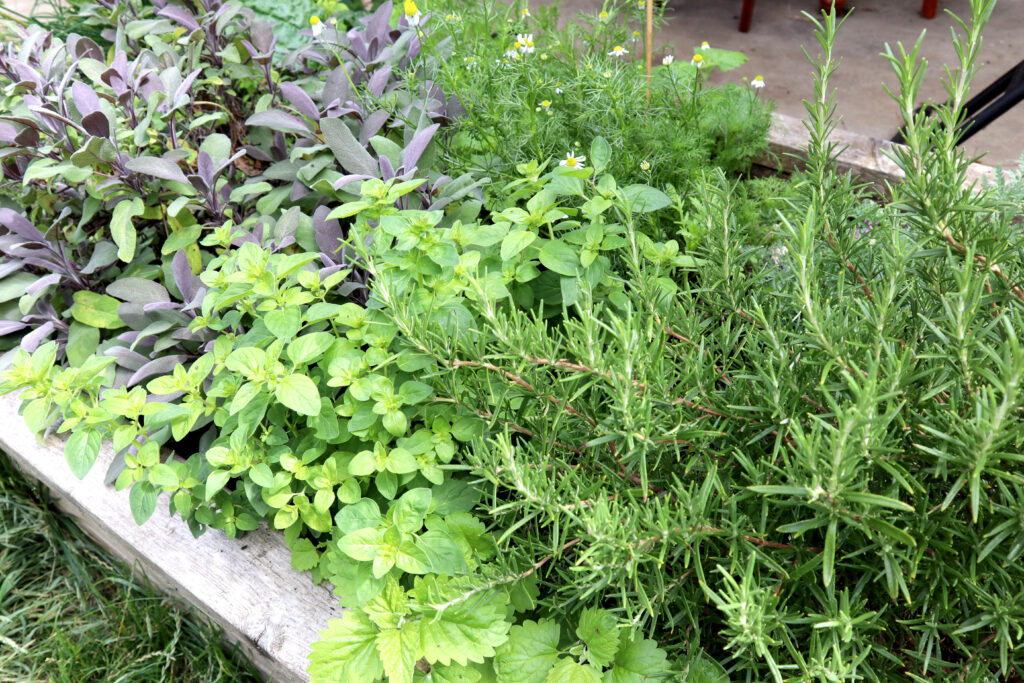
Most of these herbs can be grown in a small garden bed or in pots on a balcony or patio. You may struggle with ginkgo though, because it grows into a very large tree. We were lucky enough to have a tiny ginkgo tree in our backyard when we moved here 8 years ago, which is now about 5 metres tall and produces all our dried ginkgo.
I also grow my own lavender, calendula, and chamomile.
I also have gotu kola growing in a pot indoors but it is still too small to harvest yet. We have tried and failed to grow passionflower here pretty much every year, its just too cold and damp unfortunately.
I buy my looseleaf passionflower from Wildcraft Dispensary and gotu kola from Tea Life.
You may already have some ingredients growing in your own backyard
A few of these ingredients are literal “weeds” which grow everywhere. There’s really no such thing as a weed, that’s just capitalist propaganda.
The dandelion, cleavers, nettle and broadleaf plantain are self-seeding “weeds” which we allow to grow freely in the garden so we can harvest them as medicine and food.
I have a medicinal herb master post in the works which should help you get started on growing some of your own medicine.
Ingredients for Nervous and Immune system balancing tea
I have done my best to outline the potential benefits and risks for each herb. Again, I’m not a doctor or qualified herbalist. I strongly recommend you do your own reading about the following herbs and discuss them with a trusted medical provider, before deciding if they may be appropriate for you or not.
Chamomile (Matricaria recutita)
Chamomile flowers are beautifully soothing and calming to the nervous system. They help to relax muscles and promote sleep.
Chamomile gently supports digestive health and aids in removal of waste products. It reduces inflammation and allergies.
Caution: those with ragweed allergies may have an allergic reaction to Chamomile. It can also cause contact dermatitis.
Do NOT use chamomile if you are taking any kind of blood thinning medication, aspirin etc. Chamomile is a mild blood thinner, mixing it with other blood thinners may cause bleeding.
I have combined chamomile with ginkgo, (another blood thinner) in this recipe, but the combined amount consumed in one cup of tea per day should be safe for the vast majority of people. Reduce the ratio of one or both herbs if you’re concerned.
Passionflower (Passiflora Incarnata)
The aerial parts of the passionfruit vine are used as a gentle, yet effective and non-addictive sedative, tranquilliser and muscle relaxant. Passionflower helps with anxiety, insomnia, tension and irritability. This makes it perfect for calming a hypervigilant nervous/immune system.
Caution: passionflower can cause drowsiness. Drink your Healing Tea in the evening instead of the morning if this is an issue for you. Do not take high doses in pregnancy.
Lavender (Lavandula species)
Lavender works as a muscle relaxant and improves depression, anxiety and insomnia.
It is also antimicrobial, antibacterial, antifungal and neuroprotective, which means it can protect the body from nerve damage.
Lavender has a strong floral flavour and is very potent, which is why I only use half a part of lavender in this recipe.
Dandelion leaf (Taraxacum officianalis)
Dandelion leaf is a diuretic, detoxifying, bitter herb. It gently stimulates the liver and gallbladder to help them remove waste products caused by inflammation, infection, dietary or environmental factors.
Dandelion leaf extract has been shown to block ACE2 receptors and inhibit spike proteins (including those from covid-19) from entering cells.
Caution: Dandelion reduces blood pressure by reducing blood volume. If you have POTS, this may be an issue.
However, unlike other herbal bitters, dandelion is aquaretic. This means that its high potassium content prevents you from actually losing any potassium.
I find that by combining dandelion with a diet rich in pink Himalayan Salt, I get the right mix of electrolytes and trace minerals to keep me hydrated and functioning well. Without the microplastics found in table and most sea salt these days.
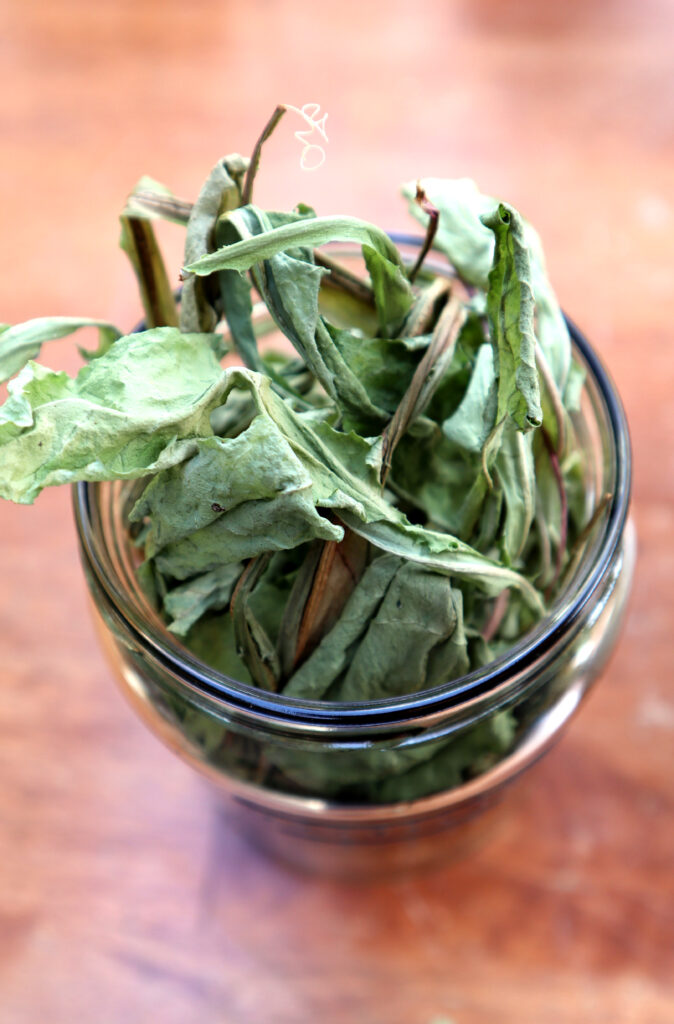
Nettle leaf (Urtica Dioica)
Nettles are packed with calcium, potassium, salicylic acid and iron. They act as a diuretic, tonic and blood builder. Like dandelion, nettle increases urination, which helps the body to effectively eliminate waste products.
Caution: nettle leaves contain histamines, so if you’re on a low histamine diet, this may be an issue. However, nettle leaves also contain quercetin, a mast cell stabiliser. They are actually used for hayfever, asthma, itchy skin conditions and insect bites. In fact, nettle juice is a common remedy for nettle stings!
Gout Kola (Centella asiatica)
Gotu Kola is an adaptogen, which means that it helps our bodies adapt to stressful situations, making us less likely to experience illness caused by stress overwhelm. It reduces anxiety and supports healthy brain function.
It’s also anti-inflammatory and excellent for wound healing and connective tissue repair, so it’s ideal for those with arthritis, or diagnosed or suspected hEDS or HSD. It also helps to repair and build new blood vessels and increase peripheral blood flow.
Caution: It can cause liver damage in rare cases, especially at high doses, so do not be tempted to use this herb to excess. Gotu Kola is also restricted in some countries.
Broadleaf Plantain (Plantago major)
The Gaelic word for this plant translates to “the healing plant”.
Broadleaf plantain contains silica, an important building block for connective tissue, along with vitamin C, K and calcium. It staunches blood flow and is used to treat wounds and bruises. It can be used similarly to comfrey for broken bones, but is much safer to take internally.
When taken internally, it is a diuretic which aids in removal of waste products from the body. It is anti-inflammatory. It heals the digestive tract, and is helpful for IBS, ulcers, digestive infections, and more. It’s also used as a treatment for various lung conditions and infections.
There are no known contraindications or specific cautions associated with this plant.
Ginkgo (Ginkgo biloba)
Ginkgo is the oldest tree on earth, appearing around 190 million years ago. It helps us to live long and healthy lives.
It reduces inflammation, especially when nerve tissue is damaged by inflammation.
Ginkgo contains quercetin, an antioxidant, and mast cell stabiliser, which inhibits the release of histamine into the bloodstream.
It is excellent for cerebral circulation, brain function, memory and concentration.
It inhibits Platelet activating factor, (a substance released by red blood cells which makes blood stickier and more likely to clot).
Caution: quercetin is not safe for pregnant or breastfeeding women, those with bleeding disorders, or those with kidney damage.
Do not take with blood thinners (including aspirin) or antiplatelet medications, this could cause bleeding.
Quercetin causes kidney damage at high doses. The combined amount from the nettle and ginkgo in one cup of this tea a day, is much lower than a supplement, and highly unlikely to cause any issues. I definitely don’t recommend more than one cup a day though.
Cleavers (Galium aparine)
Cleavers is a diuretic which supports the lymphatic system, helping our bodies to clear waste products. Waste products are the so called “toxins” which can build up in the body and lead to illness.
It’s great for treating swollen glands and general edema, as well as urinary tract issues.
Note: most herbalists recommend using fresh cleavers because it can lose its potency quickly after drying. I have found this to be the case with purchased cleavers (which looked and smelled like dried hay), but the jar of my own harvested and dried cleavers still has a strong smell and flavour over a year later.
Cleavers has no reported specific side effects or contraindications.
Calendula (Calendula officianalis)
Calendula supports the lymphatic system and cleanses the liver and gallbladder, aiding in the removal of waste products from the body.
It is anti-inflammatory and has antiviral, antibacterial, antifungal and antiseptic properties. It’s an excellent wound healer, especially for all types of skin issues.
It’s also good for chronic infections, especially in the digestive tract, and may help to reduce Candida albicans.

Nervous and Immune System Balancing Tea recipe
We drink this tea at breakfast time every morning, and I recommend you do the same. It’s like a huge shot of vitamins that gives us the best possible start to the day.
When used in my Daily Healing Tea Ritual, it also grounds me in my daily spiritual practice and gives me a sense of stability and calm throughout the day.
I prefer mine sweetened with a teaspoonful of local raw honey, but my husband Dan takes his straight. This tea has a mild and inoffensive herbal flavour, I just love the taste of honey!
Serving size
One serve of tea is approximately one heaped teaspoonful to one cup of just boiled water.
Nervous and Immune System Balancing Tea – Base recipe
The base tea is primarily for calming and balancing a dysfunctional nervous/immune system, which (along with taking probiotics) should be the first step in healing this kind of injury. These ingredients are gentle yet effective and non-addictive. They work as sedatives, tranquilisers and muscle relaxants. They help with joint, muscle and nerve pain, headches and migraines, as well as trauma, depression, anxiety and insomnia.
3 parts dried chamomile flowers
2 parts dried passionflower aerial parts (chopped into small pieces)
½ part dried lavender flowers (if using whole dried lavender heads, pull apart with your fingers)
Nervous and Immune System Balancing Tea – Extra Ingredients
The extra ingredients support waste elimination, nerve and tissue repair, circulation, brain function, stress tolerance, wound healing, and reduce allergic reactions.
All extra ingredients besides Calendula (just pull apart with your fingers) should be chopped into small pieces, around ½ cm or ¼ in. This allows them to mix easier and distribute evenly. You could probably use an herb grinder on the coarsest setting, but I prefer to just hand cut for each batch using small, sharp embroidery scissors.
1 part dried Dandelion leaf
1 part dried Nettle leaf
1 part dried Gotu Kola
1 part dried Broadleaf plantain
1 part dried Ginkgo leaf
1 part dried Cleavers (aerial parts)
1 part dried Calendula flowers (the whole flower is more potent, but if you only have access to petals, they will also work)
How to make Nervous and Immune System Balancing Tea
I use a thrifted vintage silver dessert spoon to measure out my herbs. One part equals one heaped spoonful. ½ part equals one flat spoonful. This makes enough tea for two people for about two weeks.
It doesn’t really matter what you use to measure your tea, or the quantity you make, just try to stick to the ratios listed above, until you understand how each herb affects you.
If you start to intuitively feel like you should adjust the ratio, add or subtract ingredients, you should follow your intuition. Just be sure to consult a credible source for possible contraindications or interactions before adding any new ingredients. Like a trusted medical professional or reputable herbal medicine book.
Since this is a powerful Healing Tea, it’s important to give it the respect it deserves and to focus your energy on gratitude and healing as you are collecting and combining ingredients.
Make sure your work surface and tools (spoon, scissors, jar/container) are clean and your hands are washed and dried. Gather your tools and ingredients. Try to minimise potential distractions where possible.
Getting into a meditative state
Sit down and take a few moments (or minutes – however long it takes) to breathe deeply, ground and centre yourself. Try to clear your mind of stress and worry, and enter into a calm and receptive meditative state. If you’re not quite sure how to do this, read my article on grounding techniques.
It’s very important that you do not hold any anger or resentment in your heart during this process, as these emotions prevent and delay healing. Hold this state as you prepare your batch of tea.
Take your time to measure out your ingredients one by one. Place them into a clean recycled glass jar or other airtight container (preferably not plastic).
Remember, if you are have frequent allergic reactions, you should just start with the base tea and only add one extra ingredient to each new batch of tea you make, roughly every fortnight.
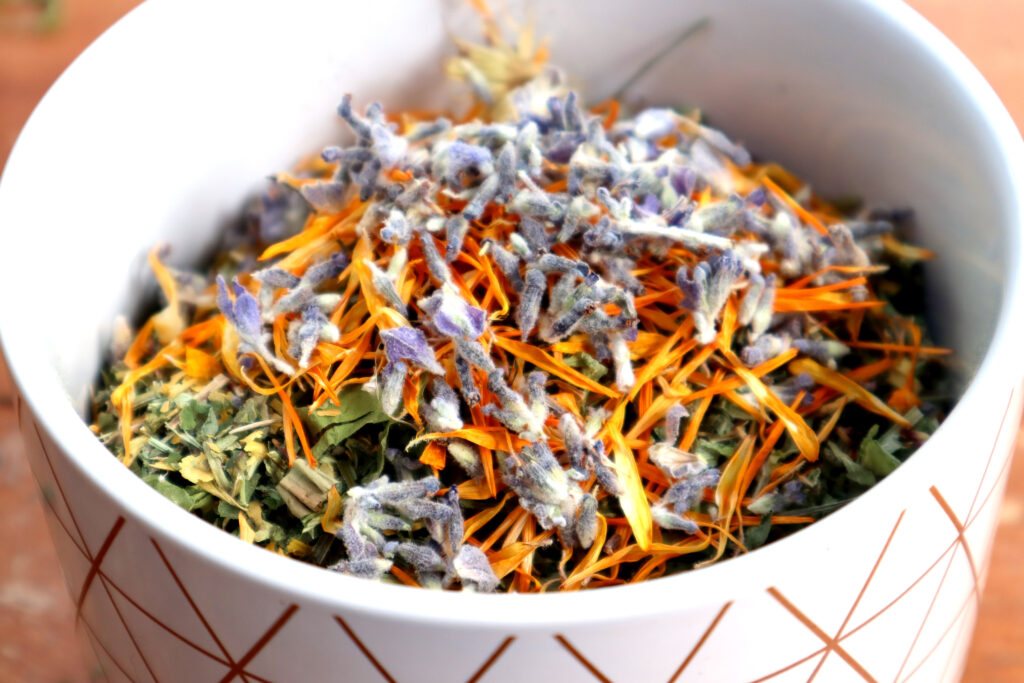
Adding your intention
When you have all your ingredients in your tea jar or container, you can start to actively add your intention and respectfully ask the herbs to heal you.
This probably sounds silly or crazy to people who have never spoken to plants, but I promise they can hear you and feel your intention.
Humans have evolved alongside plant medicine since the dawn of man. We are designed to work together (unlike humans and most pharmaceuticals).
Regardless of your skin colour, race or religion. At some point in time, your ancestors used plant medicines and shamanic techniques to work with their healing energies. It is your birthright to connect with the healing energies of nature and the practices of your ancestors. Despite what organised religion and its societal constructs may tell you.
Project your energy
You can either stir with a spoon or gently shake (with the lid on) your jar or container to distribute and combine the herbs. As you do this, express your gratitude and respectfully ask the herbs to help you to heal. You don’t need to do this out loud, just focus on projecting your thoughts and energy.
I usually (energetically not vocally) say something along the lines of:
“Dear herbs, thank you for sharing your beautiful energy. Please help us to heal and be healthy and strong. Please help us to release that which no longer serves us, to create space for healing and new growth. Thank you, my friends”.
This is just what feels right to me, but you should say whatever feels right to you.
It doesn’t need to rhyme. You don’t even need to form specific words, as long as you are expressing your feelings of gratitude and intention for release and healing.
Whenever you feel that your message has been received, the tea is ready to use in a Daily Healing Tea Ritual.
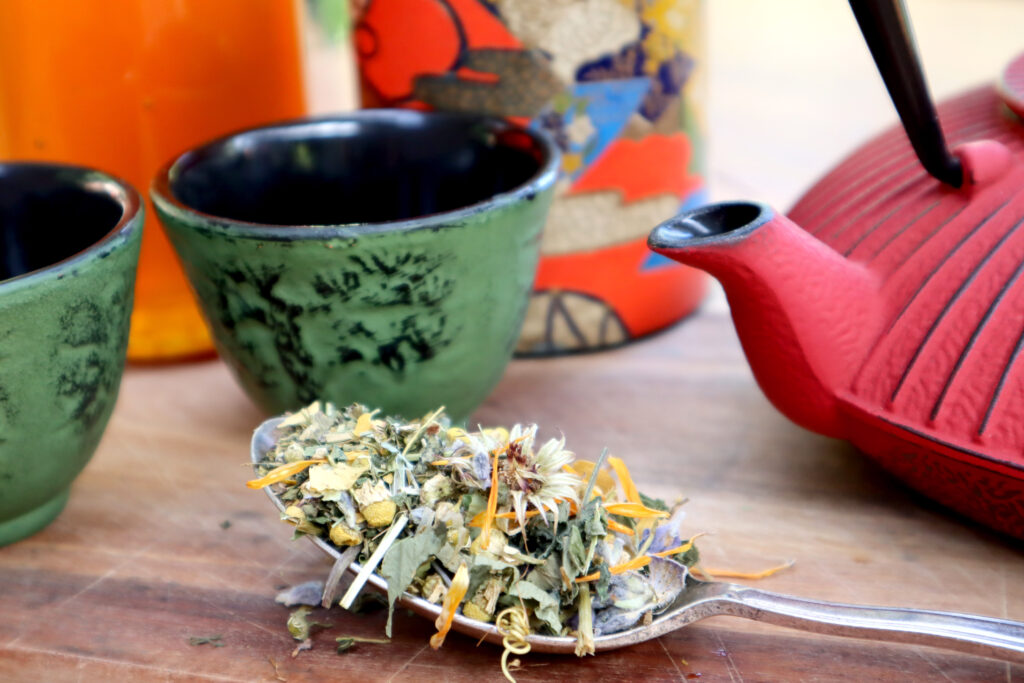
Of course you can also make this tea without the meditative sate and energetic exchange, or without using it in a Daily Healing Tea Ritual, it just won’t be anywhere near as potent.
If it makes you feel uncomfortable to use your own energy to heal yourself, you might want to examine how those limiting beliefs are holding you back from your healing birthright.
Beyond Nervous and Immune System Balancing Tea: Taking your healing further
Click the links to read my Healing articles on the following topics:
Grounding Techniques
Healing Tea Ritual
Shadow Work
Final thoughts on Nervous and Immune System Balancing Tea
This tea is packed with nutritive, healing, nervous system balancing ingredients. With how stressful the pressures of modern life are these days, most of us struggle to get the nutrients we need and regulate our nervous systems. This tea will help you do that, especially when used in conjunction with the healing techniques linked above. Along with actively reducing your commitments, obligations and life stressors.
I’d love to know if you’ve tried my Nervous/Immune System Healing Tea Recipe, and whether you found it helpful, in the comments section.
Happy tea making!
[optin-monster-inline slug=”qdfs5cowsxbtmmucnrtm”]